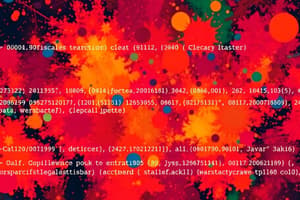Podcast
Questions and Answers
What is an Abstract Data Type (ADT)?
What is an Abstract Data Type (ADT)?
- A collection of data together with a set of operations on that data (correct)
- A type of programming language construct
- A method for hiding unnecessary details in software
- A specific implementation of a data structure
What are the typical operations on data in an ADT?
What are the typical operations on data in an ADT?
- Add data to a data collection, remove data from a data collection, ask questions about the data in a data collection (correct)
- Sort data, search for data, update data
- Create new data structures, delete data structures, modify data structures
- Allocate memory, deallocate memory, access memory
Why do Abstract Data Types (ADTs) help manage software complexity?
Why do Abstract Data Types (ADTs) help manage software complexity?
- They hide unnecessary details (correct)
- They make software maintenance more difficult
- They provide a specific implementation of data structures
- They allow for global changes in functionalities
What is the difference between an Abstract Data Type (ADT) and a data structure?
What is the difference between an Abstract Data Type (ADT) and a data structure?
How does using an Abstract Data Type (ADT) benefit a programmer?
How does using an Abstract Data Type (ADT) benefit a programmer?
What is an Abstract Data Type (ADT)?
What is an Abstract Data Type (ADT)?
Why do ADTs help manage software complexity?
Why do ADTs help manage software complexity?
What are typical operations on data in an ADT?
What are typical operations on data in an ADT?
Can a programmer use an ADT without knowing its implementation?
Can a programmer use an ADT without knowing its implementation?
What is the primary purpose of an ADT?
What is the primary purpose of an ADT?
Flashcards are hidden until you start studying



